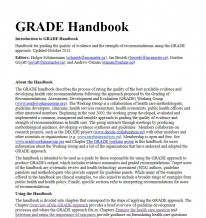The GRADE handbook describes the process of rating the quality of the best available evidence and developing health care recommendations following the approach proposed by the Grading of Recommendations, Assessment, Development and Evaluation (GRADE) Working Group (www.gradeworkinggroup.org). The Working Group is a collaboration of health care methodologists, guideline developers, clinicians, health services researchers, health economists, public health officers and other interested members. Beginning in the year 2000, the working group developed, evaluated and implemented a common, transparent and sensible approach to grading the quality of evidence and strength of recommendations in health care. The group interacts through meetings by producing methodological guidance, developing evidence syntheses and guidelines. Members collaborate on research projects, such as the DECIDE project (www.decide-collaboration.eu) with other members and other scientists or organizations (e.g. www.rarebestpractices.eu). Membership is open and free. See www.gradeworkinggroup.org and Chapter The GRADE working group in this handbook for more information about the Working Group and a list of the organizations that have endorsed and adopted the GRADE approach.
The handbook is intended to be used as a guide by those responsible for using the GRADE approach to produce GRADE's output, which includes evidence summaries and graded recommendations. Target users of the handbook are systematic review and health technology assessment (HTA) authors, guideline panelists and methodologists who provide support for guideline panels. While many of the examples offered in the handbook are clinical examples, we also aimed to include a broader range of examples from public health and health policy. Finally, specific sections refer to interpreting recommendations for users of recommendations.



